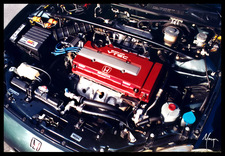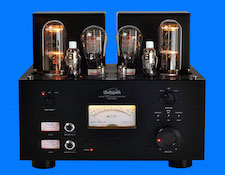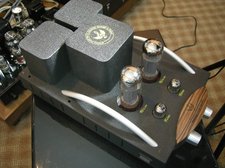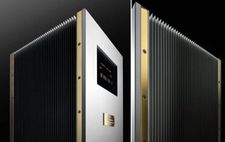It’s the time of year for saving money!
Do you know what a double overhead cam (“DOHC”) engine is? It’s a special type of internal combustion engine that has a system of valve actuation that allows it to make more power by turning at higher engine speeds (more “RPM”) than a conventional “pushrod” or “single-overhead cam” engine can. Because they can be more complex or more expensive than other designs, DOHC engines are usually found in racecars, racing or super-sport motorcycles, and other ultra-high–performance vehicles.
 They’ve also, in recent years, been fitted to at least one brand of Asian “econobox” family car — not because it needs higher than normal horsepower (which in the “detuned” low-performance-high-gas-mileage version fitted to those commuter specials and kid haulers, it’s certainly not going to have) but because “double overhead cam” sounds “technical” or because “DOHC” sounds “racy”.
They’ve also, in recent years, been fitted to at least one brand of Asian “econobox” family car — not because it needs higher than normal horsepower (which in the “detuned” low-performance-high-gas-mileage version fitted to those commuter specials and kid haulers, it’s certainly not going to have) but because “double overhead cam” sounds “technical” or because “DOHC” sounds “racy”.
It’s just like the “spoilers” or “wings” that were so often fitted to family cars in times past (and that are still seen on some models, even today) – race car features, designed either (in the case of the spoilers) to reduce aerodynamic “drag” or (for the wings) to apply positive downward force to the wheels of a racecar so that its huge horsepower doesn’t overcome available traction at very high speed.
And of what value are all the wings and DOHC engines and spoilers, (and racing stripes, and other go-fast-looking toys and goodies available for the “Famry Camry”)? No, NOT none at all; actually quite a bit! The fact is that they help to sell cars, and practical or not for the buyer, that makes them VERY practical for the manufacturer who wants to sell his vehicles.
Like it or not, it’s just the same for High-End hi-fi. I recently saw a picture of a Model 805 amplifier from Line Magnetic (China) posted on Facebook. It was really quite appealing in a sort of a “steam punk” sort of way, (If you like that kind of a look, incidentally, check out their Model 41-2 or LM-1 monoblocks) and one of the commenters on the picture said that it actually looked like something out of an old Russian bomber. (What higher compliment could there possibly be?). It had a uniquely configured (two conjoined vertical boxes) black chassis and HUGE, unusual-looking output tubes, and a number of the commenters, based just on its appearance, asked how much it cost, wanted to know who sold it, and, most importantly, said that they would like to hear one in operation.
 Huh? The interesting thing here is that the original person who posted the picture of the amp did so NOT to elicit interest, but to illustrate a question expressing concern about the the quality of Chinese audio products. Did no one notice? Did no one care? Is it really true that (to throw in an off-topic but perhaps illustrative metaphor) if a girl has a pretty-enough face (or whatever), all else about her will be forgiven?
Huh? The interesting thing here is that the original person who posted the picture of the amp did so NOT to elicit interest, but to illustrate a question expressing concern about the the quality of Chinese audio products. Did no one notice? Did no one care? Is it really true that (to throw in an off-topic but perhaps illustrative metaphor) if a girl has a pretty-enough face (or whatever), all else about her will be forgiven?
I had thought that audio was about how stuff sounds, but, at least for many people, that’s apparently not the case, and their first criterion in picking gear to consider seems to be how it looks. That’s almost certainly why so many big, or oddly-shaped, or glowing-blue-or-purple-or-white — instead of the more customary orange glow — tubes are being used in High-End electronics. As one writer said about another exotic tube amp, “weird tubes are cool“, and he wasn’t referring to their operating temperature.
Don’t get me wrong, please; I have nothing at all against tubes. In fact, in addition to my solid-state gear from Jeff Rowland Design Group, Krell, and others, I have a full system of truly exquisite stuff from VTL. I’m not even against exotic tubes: I was mightily impressed, for example, by a 211 tube-based 16 Watt per channel Class A integrated amp from Melody that I heard at the T.H.E. Newport audio Show. For a quite modest price (by High-End standards) it sounded wonderful and was able to drive 93dB (1Watt/1Meter) speakers to truly room-shaking and head-crushing volume.
 The fact is that I’m not against anything at all; I’m just pointing out that the game seems to have changed: Buyers, who used to care only (or at least first) for how a thing sounded and whether or (if not now,) when they could afford it, now seem to be caught-up in something other than just the sound of their gear, and manufacturers – always eager to go to where the interest is – are producing products to, whichever works best, meet their needs or tickle their fancy.
The fact is that I’m not against anything at all; I’m just pointing out that the game seems to have changed: Buyers, who used to care only (or at least first) for how a thing sounded and whether or (if not now,) when they could afford it, now seem to be caught-up in something other than just the sound of their gear, and manufacturers – always eager to go to where the interest is – are producing products to, whichever works best, meet their needs or tickle their fancy.
Isn’t that exactly the same thing that the car manufacturers do when they streamline their econoboxes and put DOHC engines in them? It’s good marketing in either case.
And it’s also good for another reason, too: Using an exotic tube even when something more ordinary (or even solid-state) might work just as well is a great way to justify charging more money for your products. (Or, even if you DON’T charge more, to give — just like putting a “racecar” engine in the family sedan does — the impression of greater value at the same price.) Tubes, just in themselves are expensive, and peculiar tubes, by virtue of their exotic size or shape, seem, whether they are or not, even more expensive. When a manufacturer can use something that, in itself, can easily be recognized as expensive and use it as the basis for increasing the price of his product and having the public happily pay it, that’s not only good marketing, it’s good business.
]]>Some years ago, (probably twenty or more, but who’s counting?) Goldmund offered “goldcube” amplifiers” that plugged directly into its most expensive speakers, eliminating the need for speaker cables. If I remember correctly, these were monoblock amps that were something like 8 ½ inches on a side; that put out something like 125 Watts each into 4 Ohms; that were built on chassis that had been 18K gold-plated inside and out; and that sold for something around US$25,000 a pair, depending on the market price of gold at the time of sale.
 Hmmm… 8 ½ inches x 8 ½ inches (assuming that’s the correct dimension) = 72.5 square inches per side of the cube X 6 [for a cube’s 6 sides] = 433.5 square inches. If the gold plating was applied at a very generous 5 microns thick (1 inch = 25,400 microns, so 5 microns would be 1/5080″ = .00019685″), the total amount of gold used in the plating of the amplifiers would be 0.085335 cubic inches X 2 (for both inside and outside) X 2 (remember that it’s a PAIR of amplifiers) = 0.34134 cubic inches of gold, which would have weighed 3.4676 Troy ounces and would have been worth, in 1990, (= US$383.51 per Troy ounce X 3.4676 Troy ounces =) US$1329.86. if it had been 24k gold.
Hmmm… 8 ½ inches x 8 ½ inches (assuming that’s the correct dimension) = 72.5 square inches per side of the cube X 6 [for a cube’s 6 sides] = 433.5 square inches. If the gold plating was applied at a very generous 5 microns thick (1 inch = 25,400 microns, so 5 microns would be 1/5080″ = .00019685″), the total amount of gold used in the plating of the amplifiers would be 0.085335 cubic inches X 2 (for both inside and outside) X 2 (remember that it’s a PAIR of amplifiers) = 0.34134 cubic inches of gold, which would have weighed 3.4676 Troy ounces and would have been worth, in 1990, (= US$383.51 per Troy ounce X 3.4676 Troy ounces =) US$1329.86. if it had been 24k gold.
It wasn’t though; it was 18K, which includes 25% other, less expensive metals, so we can probably guess that Goldmund’s real cost for the plating was something around or less than US$1,100.
And what would that something-like-US$1,100 have bought? For the purchaser: good looks, pride of ownership, and no additional performance whatsoever. And for Goldmund, the ability to charge 1% more for the entire amplifier (even though the gold plate was only a tiny part of its total construction) every time the price of gold went up by 1%, and to do so at the 24K, rather than the 18K price!
Shiny bits and pieces; technologies that are sometimes real breakthroughs and sometimes just for show; and cosmetic and performance design that can cover the whole range from ordinary to inspired are what go into and help to sell our modern High-End audio products. As to which will tip the balance and actually make or break the sale, I haven’t got a clue: That’s entirely up to the customer, and that’s the way it ought to be.





